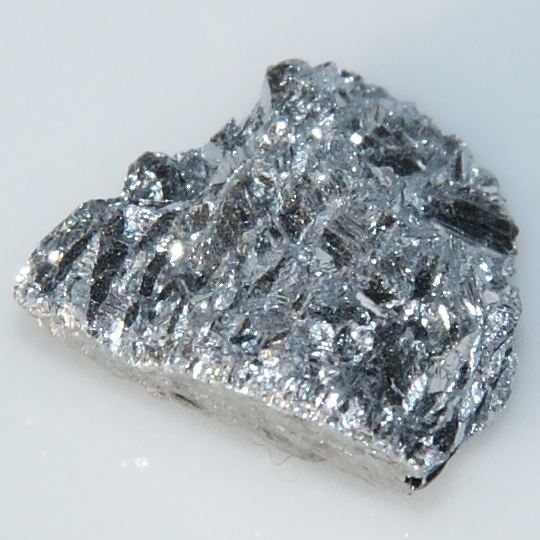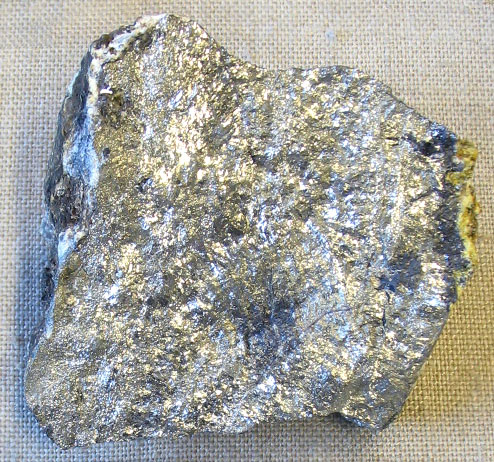Antimony is a chemical element with the symbol Sb (from Latin stibium) and atomic number 51. A lustrous gray metalloid, it is found in nature mainly as the mineral stibnite.
Antimony compounds have been known since ancient times and were powdered for use as medicine and cosmetics, often known by the Arabic name kohl.
China is the largest producer of antimony and its compounds, with most production coming from Hunan.
The largest applications for metallic antimony are in alloys with lead and tin.

SONY DSC
Facts
Antimony is a chemical element with the symbol Sb
Antimony's periodic symbol comes from Jons Jakob Berzelius, who used the abbreviation for stibium.
Antimony atomic number is 51
Antimony was named after the Greek words anti and monos to mean “a metal not found alone.”
Elemental antimony is a brittle, silver-white, shiny metalloid.
The abundance of antimony in the Earth's crust is estimated at 0.2 parts per million
The earliest known description of the metal in the West was written in 1540 by Vannoccio Biringuccio.
Antimony compounds have been known since ancient times and were used as medicine and cosmetics
They often went by the Arabic name kohl
Antimony is a member of group 15 of the periodic table
Antimony is one of the elements called pnictogens
Antimony is stable in air at room temperature
Antimony is resistant to attack by acids.
Antimony reacts with oxygen when it is heated.
Antimony has two stable isotopes: 121Sb and 123Sb
121Sb has a natural abundance of 57.36% and 123Sb has a natural abundance of 42.64%
It has 35 radioisotopes
Antimony is found in more than 100 mineral species
China accounted for 54.5% of total antimony production, followed in second place by Russia with 18.2% and Tajikistan with 15.5%
Antimony is considered to be a critical mineral for industrial manufacturing that is at risk of supply chain disruption.
No new antimony deposits have been discovered in over ten years, so the current stock is being depleted.
Other countries that make antimony are Myanmar and Australia
Antimony and many of its compounds are toxic
The effects of antimony poisoning are similar to arsenic poisoning.
Inhalation of antimony dust is harmful and in certain cases may be fatal.
In small doses, antimony causes headaches, dizziness, and depression.
Antimony leaches from polyethylene terephthalate (PET) bottles into liquids

Uses
Antimony sulfide was used in predynastic Egypt as an eye cosmetic called kohl
Antimony trioxide is an additive used for halogen-containing flame retardants.
It is used as an alloy with lead in the pipes of pipe organs
Antimony is also used as a dopant in semiconductor devices.
It makes an alloy with lead. This alloy, 5% antimony and 95% lead, is harder than pure lead.
Approximately 48% of antimony is used in flame retardants, 33% in lead–acid batteries, and 8% in plastics.
Antimony sulfide is used in the heads of some safety matches
Some lead-free solder has antimony in it
It is used as an alloy with lead in ammunition for small arms
Information
| Pronunciation |
AN-tə-mə-nee |
|||||||||||||||||||||||||
|---|---|---|---|---|---|---|---|---|---|---|---|---|---|---|---|---|---|---|---|---|---|---|---|---|---|---|
| Appearance | silvery lustrous gray | |||||||||||||||||||||||||
| Standard atomic weight Ar°(Sb) | ||||||||||||||||||||||||||
|
||||||||||||||||||||||||||
| Atomic number | 51 | |||||||||||||||||||||||||
| Group | group 15 (pnictogens) | |||||||||||||||||||||||||
| Period | period 5 | |||||||||||||||||||||||||
| Block | p-block | |||||||||||||||||||||||||
| Electron configuration | [Kr] 4d10 5s2 5p3 | |||||||||||||||||||||||||
| Electrons per shell | 2, 8, 18, 18, 5 | |||||||||||||||||||||||||
| Physical properties | ||||||||||||||||||||||||||
| Phase at STP | solid | |||||||||||||||||||||||||
| Melting point | 903.78 K (630.63 °C, 1167.13 °F) | |||||||||||||||||||||||||
| Boiling point | 1908 K (1635 °C, 2975 °F) | |||||||||||||||||||||||||
| Density (near r.t.) | 6.697 g/cm3 | |||||||||||||||||||||||||
| when liquid (at m.p.) | 6.53 g/cm3 | |||||||||||||||||||||||||
| Heat of fusion | 19.79 kJ/mol | |||||||||||||||||||||||||
| Heat of vaporization | 193.43 kJ/mol | |||||||||||||||||||||||||
| Molar heat capacity | 25.23 J/(mol·K) | |||||||||||||||||||||||||
Vapor pressure
|
||||||||||||||||||||||||||
| Atomic properties | ||||||||||||||||||||||||||
| Oxidation states | −3, −2, −1, 0, +1, +2, +3, +4, +5 (an amphoteric oxide) | |||||||||||||||||||||||||
| Electronegativity | Pauling scale: 2.05 | |||||||||||||||||||||||||
| Ionization energies |
|
|||||||||||||||||||||||||
| Atomic radius | empirical: 140 pm | |||||||||||||||||||||||||
| Covalent radius | 139±5 pm | |||||||||||||||||||||||||
| Van der Waals radius | 206 pm | |||||||||||||||||||||||||
| Other properties | ||||||||||||||||||||||||||
| Natural occurrence | primordial | |||||||||||||||||||||||||
| Crystal structure | rhombohedral | |||||||||||||||||||||||||
| Speed of sound thin rod | 3420 m/s (at 20 °C) | |||||||||||||||||||||||||
| Thermal expansion | 11 µm/(m⋅K) (at 25 °C) | |||||||||||||||||||||||||
| Thermal conductivity | 24.4 W/(m⋅K) | |||||||||||||||||||||||||
| Electrical resistivity | 417 nΩ⋅m (at 20 °C) | |||||||||||||||||||||||||
| Magnetic ordering | diamagnetic | |||||||||||||||||||||||||
| Molar magnetic susceptibility | −99.0×10−6 cm3/mol | |||||||||||||||||||||||||
| Young's modulus | 55 GPa | |||||||||||||||||||||||||
| Shear modulus | 20 GPa | |||||||||||||||||||||||||
| Bulk modulus | 42 GPa | |||||||||||||||||||||||||
| Mohs hardness | 3.0 | |||||||||||||||||||||||||
| Brinell hardness | 294–384 MPa | |||||||||||||||||||||||||
| CAS Number | 7440-36-0 | |||||||||||||||||||||||||
| History | ||||||||||||||||||||||||||
| Discovery | Arab alchemists | |||||||||||||||||||||||||
| Symbol | “Sb”: from Latin stibium ‘stibnite' | |||||||||||||||||||||||||
|
||||||||||||||||||||||||||
